Hue vs Hoi An: The Ultimate Guide for First-Time Travelers (2025)
Are you planning your first trip to Vietnam and unsure whether to choose Hue or Hoi An? In this guide, we’ll break down everything you need to know about Hue vs Hoi An—history, architecture, food, weather, stunning beaches, and charming countryside. By the end, you’ll have all the insights to choose the destination that fits your travel style best!
A Quick Comparison
History Comparison
Architecture Comparison
Cuisine Comparison
Beach Comparison
River Comparison
Village Comparison
Festival Comparison
Weather Comparison
FAQs
Hue vs Hoi An: A Quick Comparison
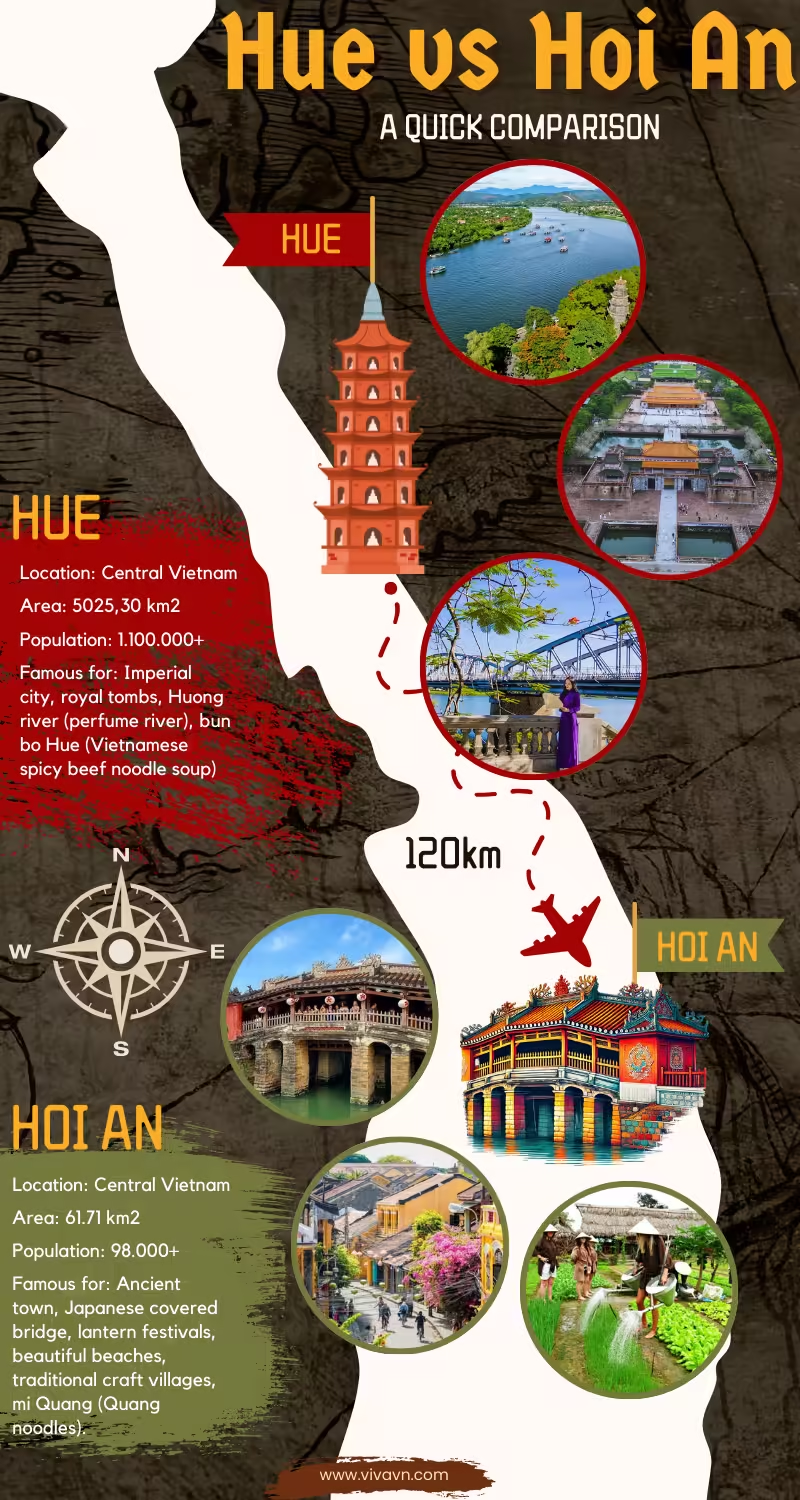
Geography and population overview of Hue and Hoi An
Hue, a city located in central Vietnam, has a population of over 1.1 million people and covers an area of 5,025.30 square kilometers (1,940.45 square miles). Around 120 kilometers (75 miles) to the south is Hoi An, a small town in Quang Nam Province with a population of over 98,000. Hoi An is much smaller, covering just 61 square kilometers (23.8 square miles).
Both cities are famous travel destinations in Vietnam, each with its own unique beauty, rich historical significance, and vibrant culture. In 1993, UNESCO officially recognized the Complex of Hue Monuments as a World Heritage Site, and in 1999, the ancient town of Hoi An was also recognized as a World Cultural Heritage site.
The History of Hue vs. The History of Hoi An (Royalty vs. Trade)
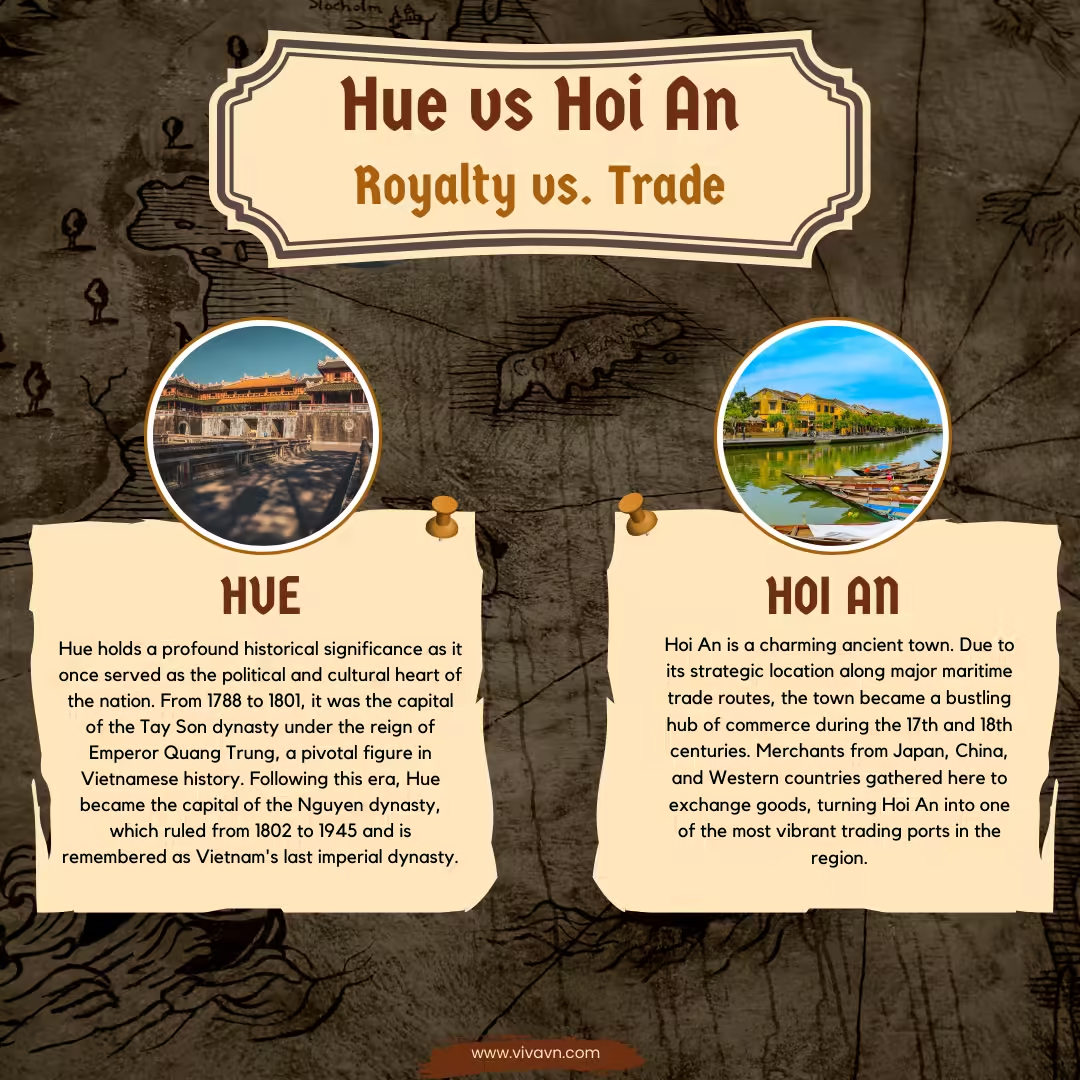
Hue used to be the capital of Vietnam during the Tay Son Dynasty (1788–1801), under the rule of Emperor Quang Trung. Later, it became the capital of the Nguyen Dynasty from 1802 to 1945, with 13 emperors. It was also the last feudal dynasty in Vietnam.
Hoi An sits along the Thu Bon River, one of Vietnam’s major waterways, with its eastern edge touching the East Sea. Thanks to its prime location and favorable climate, it became a perfect stop for both local and international trading ships. In the 17th and 18th centuries, Hoi An thrived as a lively international trading hub, drawing merchants from Japan, China, and many other places. This blend of cultures turned Hoi An into one of Vietnam’s most unique multicultural cities—a legacy you can still see and feel today.
Hue Architecture vs. Hoi An Architecture (Grand vs. Quaint)
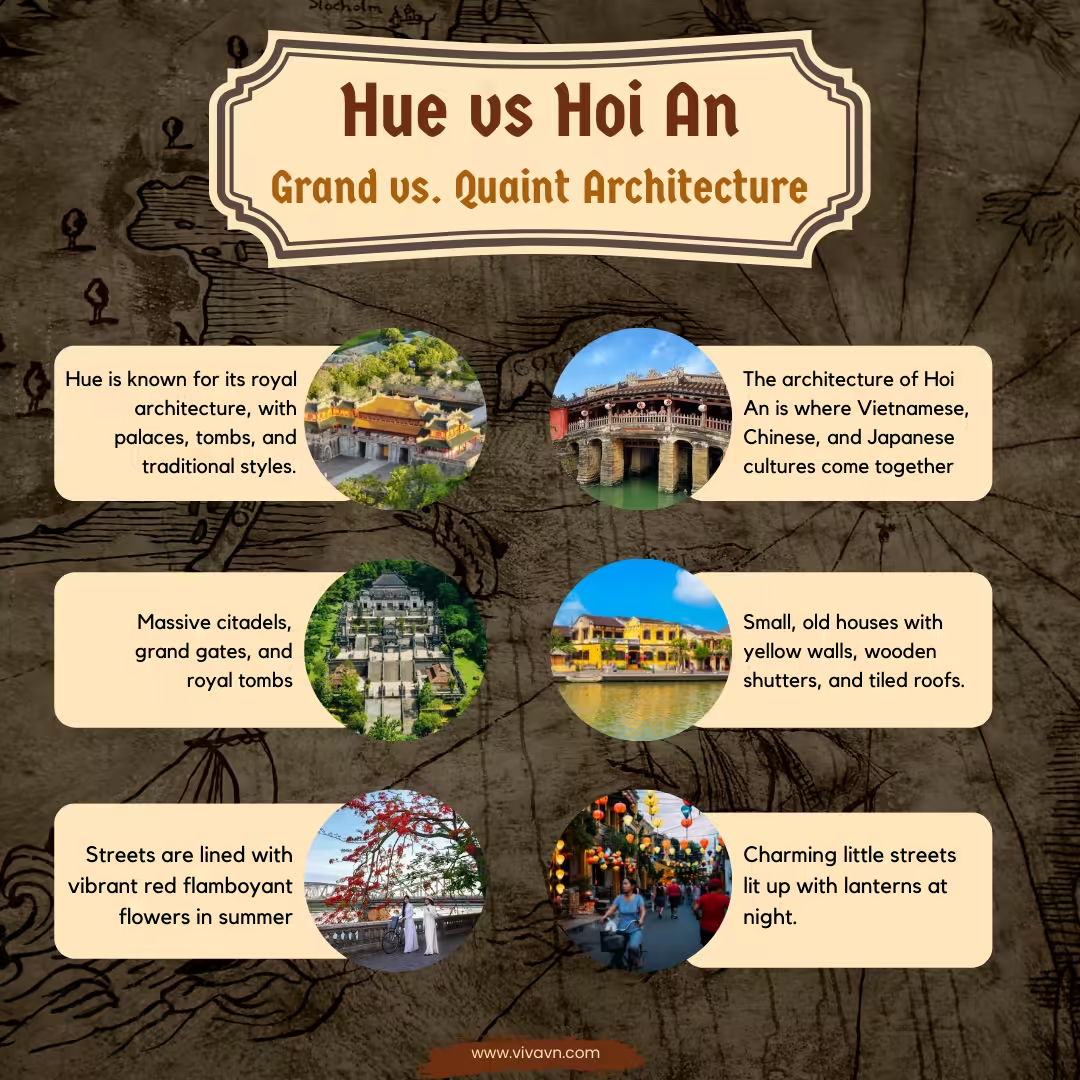
Hue Architecture
The architecture in Hue is rich and diverse, with the most notable being the imperial palaces, tombs, and religious buildings. The most famous architectural landmark is the Imperial City of Hue, covering over 5 square kilometers (about 1.93 square miles). It was built by Emperor Gia Long starting in 1805 and completed in 1832.
Successive Nguyen emperors also constructed various citadels and palaces, with around 140 structures still standing today. In addition to these, the royal tombs of the Nguyen emperors are scattered around the city, each with its own unique beauty. Hue is also home to many religious buildings, such as temples and pagodas, that reflect traditional Vietnamese folk architecture.
Hoi An Architecture
The architecture in Hoi An reflects a blend of Vietnamese, Japanese, and Chinese cultures. The streets are narrow and winding, laid out in a grid-like pattern. Along these streets, you’ll find important architectural landmarks as well as ancient houses that showcase the distinctive style of Hoi An’s architecture.
These ancient houses, hundreds of years old, are characterized by yellow walls and moss-covered tile roofs, giving them a nostalgic charm. The Chinese assembly halls, built in the 16th and 17th centuries, feature traditional Chinese architectural elements. Another iconic feature is the Chua Cau (Japanese Bridge), a symbol of Hoi An, which blends Japanese, Chinese, and Vietnamese design in its structure.
Hue Cuisine vs. Hoi An Cuisine (Bold Flavors vs. Cultural Fusion)
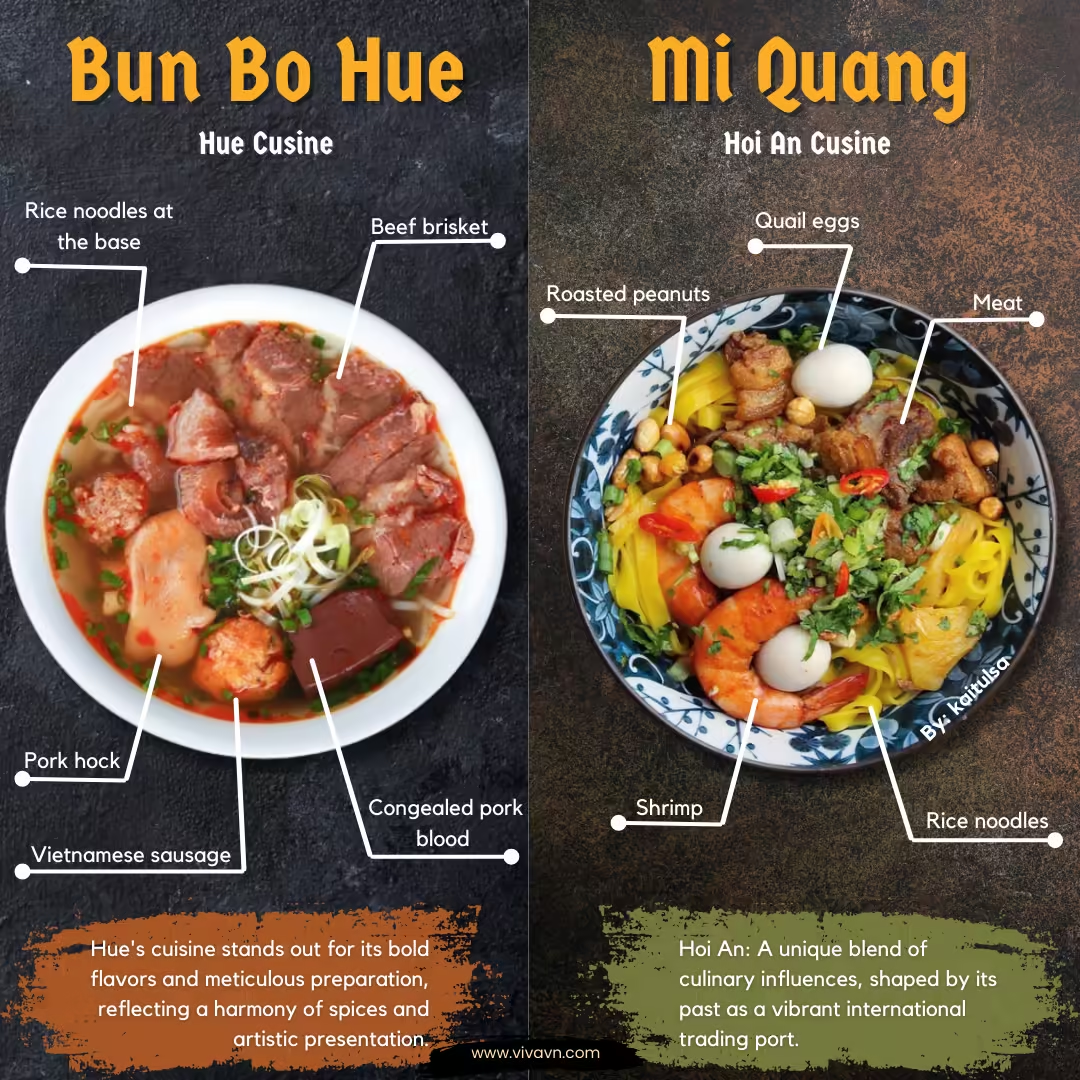
Bun Bo Hue and Mi Quang are two popular dishes that highlight the cuisines of Hue and Hoi An (credit: Photo of Mi Quang by Kaitulsa).
Hue cuisine
Hue cuisine is known for its intricate preparation, influenced by the royal court culture. Chefs pay great attention to the presentation of the dishes, ensuring they are not only delicious but visually appealing. When visiting Hue, travelers can enjoy three main types of food: royal cuisine, traditional dishes, and vegetarian food. Some of the most famous dishes in Hue include Bun Bo Hue (Hue-style beef noodle soup), Com Hen (rice with baby clams), various types of cakes, and sweet soup.
Bun Bo Hue and Pho are two of Vietnam’s most iconic dishes, that captivate anyone who tries them. Are you curious about the difference between Pho and Bun Bo Hue? Check out our detailed post!
Hoi An cuisine
Hoi An’s food is a delightful mix of Vietnamese, Chinese, and Japanese flavors. Once a bustling port town, it attracted Chinese and Japanese traders who settled here and brought their unique culinary traditions. Over time, this led to a fusion of flavors from all three cultures. Notable dishes like Cao Lau (a noodle dish), Hoanh Thanh, and Mi Quang (Quang noodles) are prime examples of this cultural blend.
If you’re new to Vietnam, explore our guide to the best Vietnamese dishes every first-time visitor should try!
Hue Beaches vs. Hoi An Beaches (Calm vs. Vibrant)
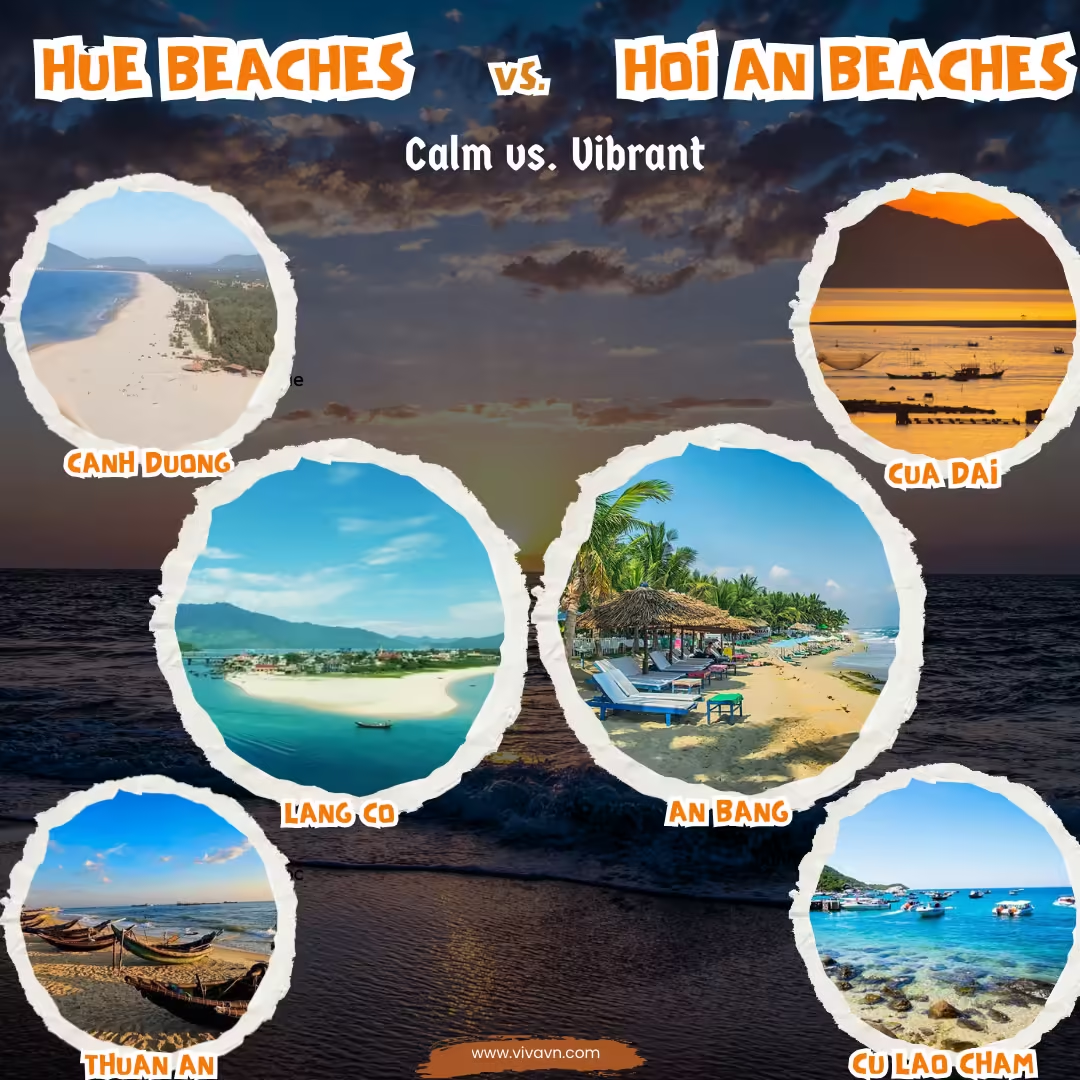
Hue beaches
The beaches in Hue are known for their serene, untouched beauty, and most of them are located far from the city. The most famous beaches are found in Lang Co Bay, located at the foot of the Hai Van Pass, offering beautiful natural scenery. Lang Co Bay is considered one of the most beautiful bays in the world. Other notable beaches in Hue include Thuan An Beach and Canh Duong Beach.
Hoi An beaches
The beaches in Hoi An are just a short distance from the Ancient Town, and biking from the town to the beach is a favorite activity for many visitors. These beaches are known for soft, white sand, gentle waves, and rows of palm trees swaying in the wind.
Along the coastline, you’ll find plenty of seafood restaurants offering fresh local dishes. The most famous beach here is An Bang Beach, often ranked as one of the most beautiful beaches in the world. Other popular spots include Cua Dai Beach, Ha My Beach, and the beaches on Cu Lao Cham Island, which is about 20 km from Hoi An and accessible by boat.
Huong river (Hue) vs. Hoai river (Hoi An)
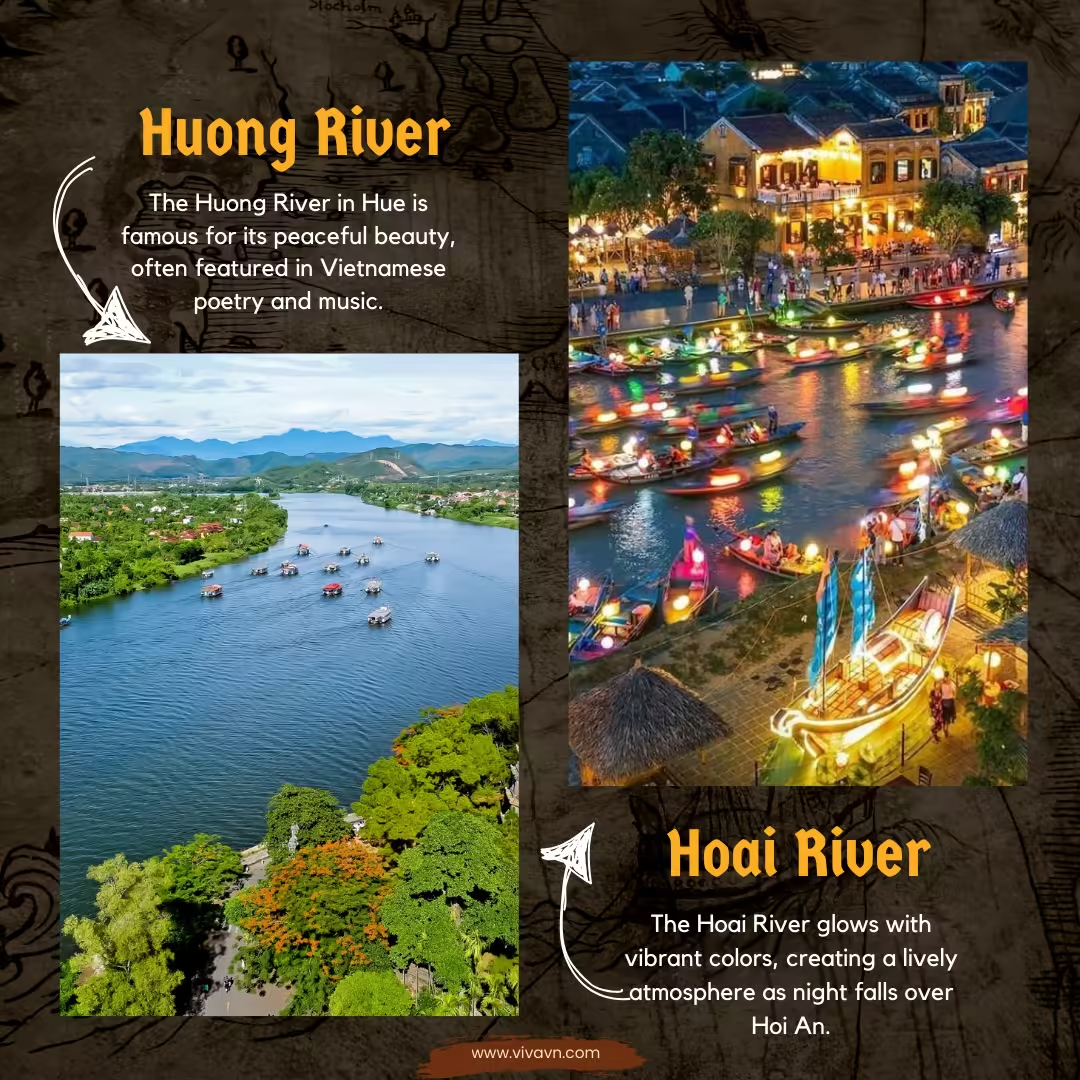
Credit: Photo of the Huong River by Nam Anh and An Thuong/Dan Tri.
Huong river
Huong River, flowing through the city of Hue, is known for its tranquil and poetic beauty. Its charm has been immortalized in literature and music, becoming a symbol of the city. To truly experience the beauty of the river, you can take a boat ride, enjoy traditional Hue folk music, and admire the iconic Truong Tien Bridge, along with other famous landmarks lining both sides of the river.
Hoai river
The Hoai River, flowing through the ancient town of Hoi An, is a branch of the larger Thu Bon River. The beauty of the Hoai River truly comes alive at night, when the entire river is illuminated by the soft glow of lanterns hanging from boats. The warm, colorful lights reflect on the water, creating a peaceful atmosphere that perfectly complements the charm of Hoi An’s historic streets.
Hue Villages vs. Hoi An Villages
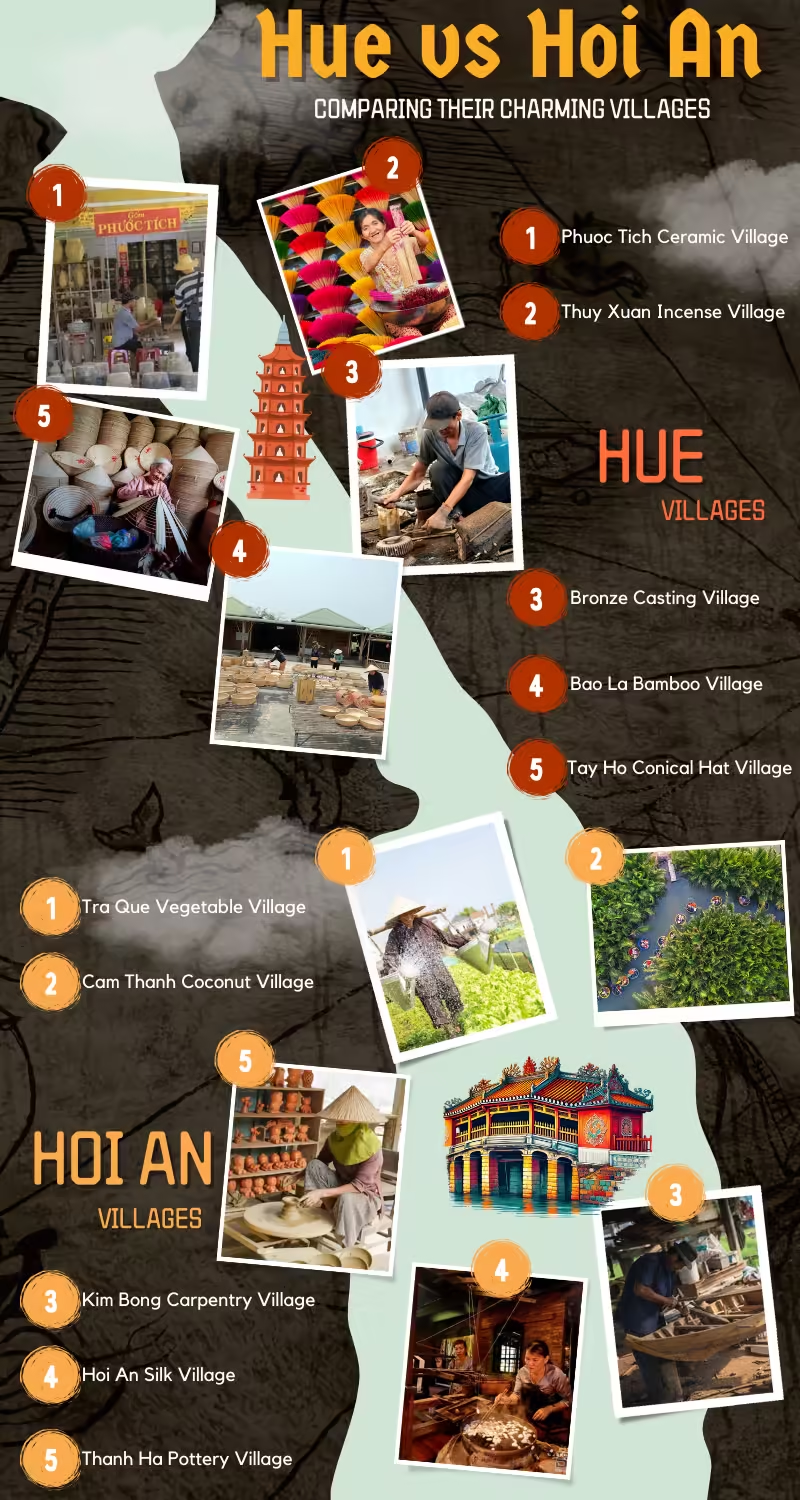
Hue’s Heritage Villages
Hue is known for its traditional craft villages that showcase the city’s culture and history. If you love the iconic conical hats worn by Vietnamese women, visit Tay Ho conical hat-making village. For eco-friendly bamboo products, Bao La village is the place to go. And if you’re curious about how incense sticks are made for Vietnamese ancestor worship, don’t miss Thuy Xuan incense-making village. These villages are a great way to experience Hue’s traditions up close.
Hoi An’s Local Villages
Hoi An is home to charming villages that beautifully showcase the essence of rural Vietnam. If you’re curious about how Vietnamese farmers grow vegetables, visit Tra Que vegetable village, which has been around for over 400 years. For a serene escape into nature, explore the lush coconut forests of Cam Thanh coconut village.
You can also stop by Kim Bong Carpentry Village to see skilled artisans craft stunning wooden creations. Additionally, Thanh Ha pottery village offers a glimpse into traditional ceramic-making techniques, while Hoi An Silk Village invites you to learn about the intricate process of silk production.
Comparing Festivals in Hue and Hoi An
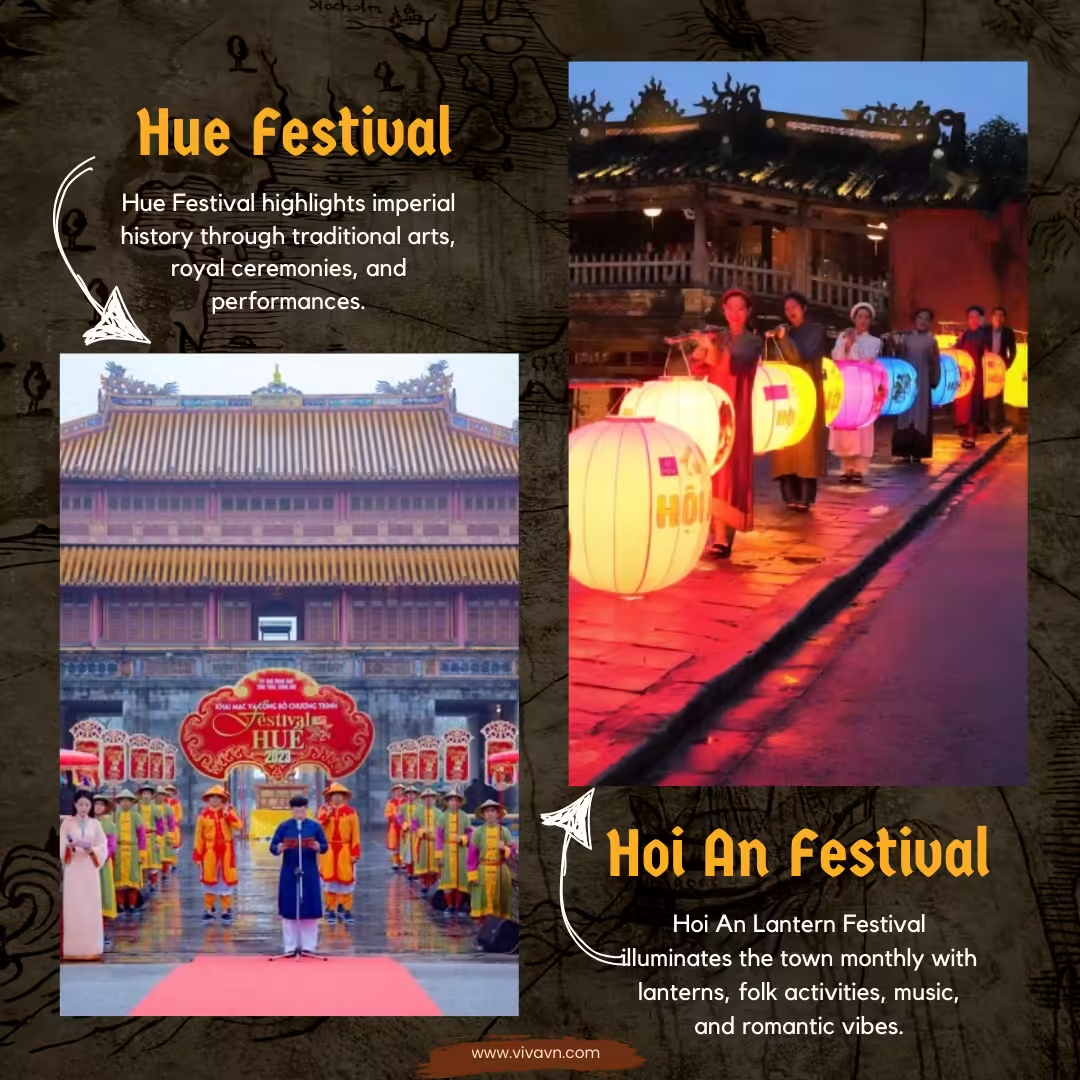
The festivals in Hue and Hoi An are both rich in culture but offer different experiences:
Hue festivals
Hue’s most famous festival is the Hue Festival, held every two years. It’s a large-scale event showcasing traditional arts, royal ceremonies, and performances, reflecting Hue’s imperial history. The atmosphere is formal and historic, with parades, art exhibitions, and classical music performances.
Hoi An festivals
Hoi An is known for its Lantern Festival on the 14th day of each lunar month. The town lights up with colorful lanterns, and people release flower candles on the Hoai River, creating an enchanting and romantic vibe. The festival features traditional folk activities, music, and games, offering a more relaxed, charming experience.
Hue vs Hoi An: Weather Comparison
What is Hue’s Weather Like Throughout the Year?
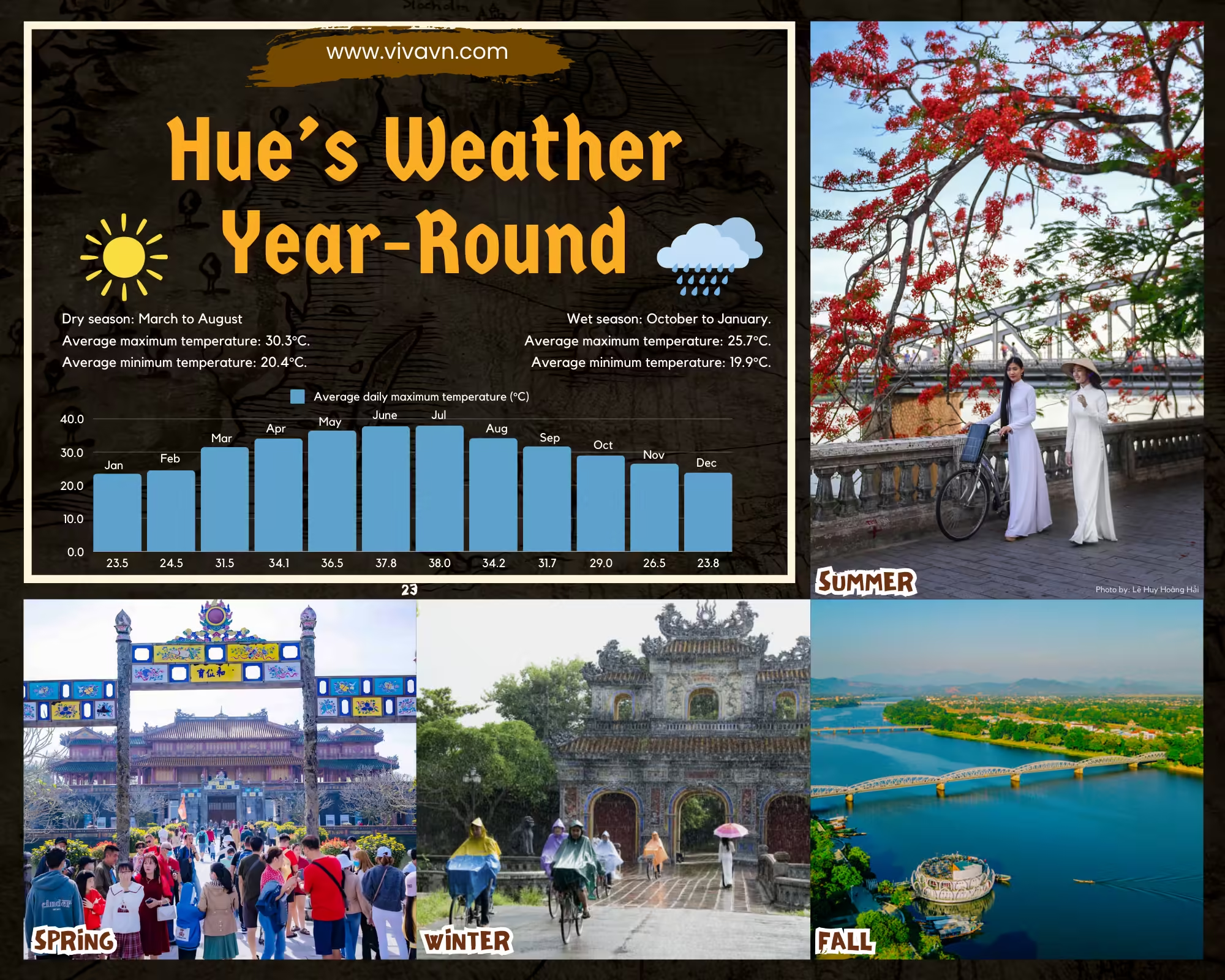
Credit: Photo of summer in Hue by Le Huy Hoang Hai/VnExpress.
Spring (late January to March): Hue experiences mild and pleasant weather in spring, with soft sunshine and occasional cool breezes. This is the best time to explore local culture and traditions.
Summer (April to July): Summers in Hue are hot and sunny, perfect for beach visits, hiking, and enjoying stunning sunrises and sunsets. From June to August, the sea is at its clearest and most beautiful.
Fall (August to September): Fall is Hue’s most picturesque season, with cool weather, light sunshine, and occasional rain showers. This is ideal for exploring Hue’s streets, admiring fall foliage, and taking in the peaceful Huong River.
Winter (October to January): Winter brings frequent rains, especially in October and November, with potential storms and floods.
What is Hoi An’s Weather Like Throughout the Year?
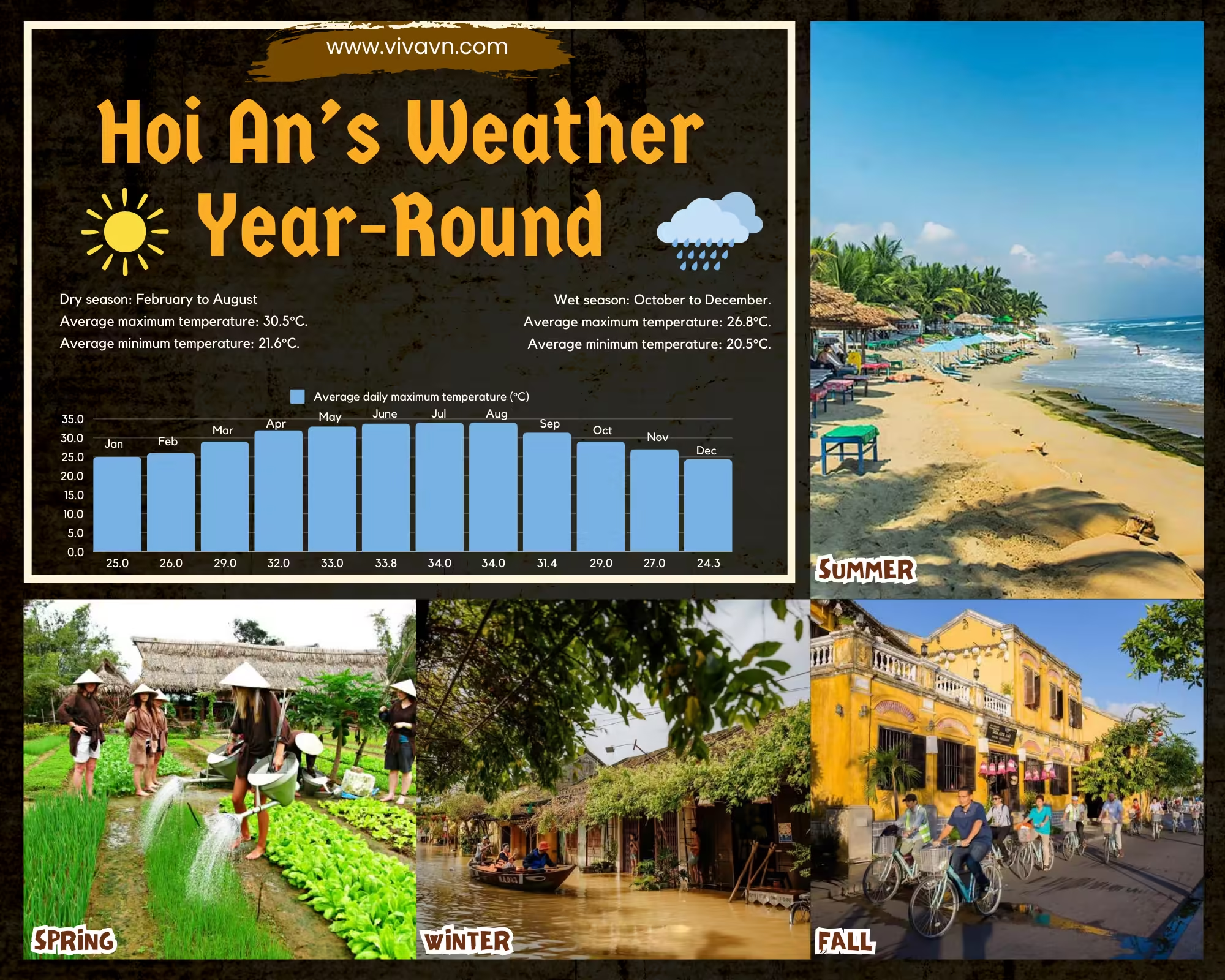
Spring (January to March): Hoi An enjoys cool weather with gentle sunshine and occasional light rain. This is an ideal time for leisurely exploration and outdoor activities.
Summer (April to July): This is the hottest period of the year. These sunny months are perfect for beach trips, exploring the countryside, and enjoying Hoi An’s vibrant lantern-lit evenings.
Fall (August to September): A transitional season with light sunshine, refreshing afternoon showers, and cooler evenings.
Winter (October to December): The rainy season brings frequent showers and occasional flooding.
Unique experience: During the rainy season, Hoi An floods turn the town into a water-filled wonderland, offering a unique chance to explore the ancient streets by boat—an unforgettable experience!
Common FAQs for First-Time Travelers to Hue and Hoi An
Should I visit Hue or Hoi An?
Hue is perfect for those who love history, ancient royal architecture, and experiencing traditional Vietnamese culture. Its imperial citadels and royal tombs offer a fascinating glimpse into Vietnam’s past.
On the other hand, Hoi An is ideal for those seeking a charming old town atmosphere, with its iconic lantern-lit streets, a unique mix of Vietnamese, Chinese, and Japanese influences, and beautiful nearby beaches to relax and unwind.
How far is Hoi An from Hue, and how long does it take to get there?
Hoi An is approximately 120 kilometers (about 75 miles) from Hue. The travel time depends on the mode of transportation you choose:
- By car or shuttle bus: It takes around 2.5 to 3 hours.
- By motorbike: It usually takes about 3 hours, depending on traffic and stops along the way.
- By train: The train ride from Hue to Da Nang takes about 3 hours. Once you arrive at Da Nang station, you’ll need to take a bus, taxi, or motorbike for another 30-45 minutes to reach Hoi An.
Is it easy to travel between Hue and Hoi An?
Yes, it’s easy to travel between Hue and Hoi An. You can get from Hue to Hoi An by train, shuttle bus, private car, or motorbike. If you take the train, you will stop at Da Nang Station, which is located in Da Nang city. From there, you need to travel another 30km to reach Hoi An.
What is the best way to travel from Hue to Hoi An?
We recommend taking the train for a unique experience. The train ride along Hai Van Pass offers amazing views of the mountains and the ocean. However, keep in mind that the train will only take you to Da Nang station, which is about 30 km from Hoi An. From there, you can easily continue your journey by taxi, bus, motorbike or private car. If you’re looking for even more adventure, riding a motorbike is a great option, letting you enjoy the beautiful scenery up close as you make your way to Hoi An.
Is there a direct flight from Hue to Hoi An?
There are no direct flights from Hue to Hoi An . To travel between Hue and Hoi An, you’ll need to use other methods like by train, shuttle bus, private car, or motorbike.
Which city has better beaches: Hue or Hoi An?
Both cities offer beautiful beaches, but we think Hoi An has the edge when it comes to beach quality. For example, An Bang Beach is considered one of the most stunning beaches in Asia. Plus, it’s just about 3km from the ancient town, making it an easy bike ride away. In contrast, the beaches in Hue are located much further from the city center, requiring a longer trip to reach them.
Which city has the best food: Hue or Hoi An?
Both cities offer amazing food, but with flavors that are a bit different. Hue’s dishes are bolder and more complex. When in Hue, we recommend trying Bun Bo Hue (spicy beef noodles), Com Hen (rice with clams), and traditional Hue-style meals.
Hoi An, on the other hand, has lighter, delicate flavors with influences from Vietnamese, Chinese, and Japanese cuisines. Must-tries in Hoi An include Mi Quang (Quang noodles), Cao Lau (noodles with pork), Banh Mi Phuong (Vietnamese sandwich), and Com Ga (chicken rice).
Share on FacebookShare on X (Twitter)Share on PinterestShare on WhatsappShare on LinkedinShare on TelegramShare on Email
- https://www.youtube.com/@VivaVNOfficial
- https://www.facebook.com/vivavnofficial2024
- https://www.pinterest.com/vivavnofficial/
© 2025 VivaVN. All rights reserved.

Leave a Reply